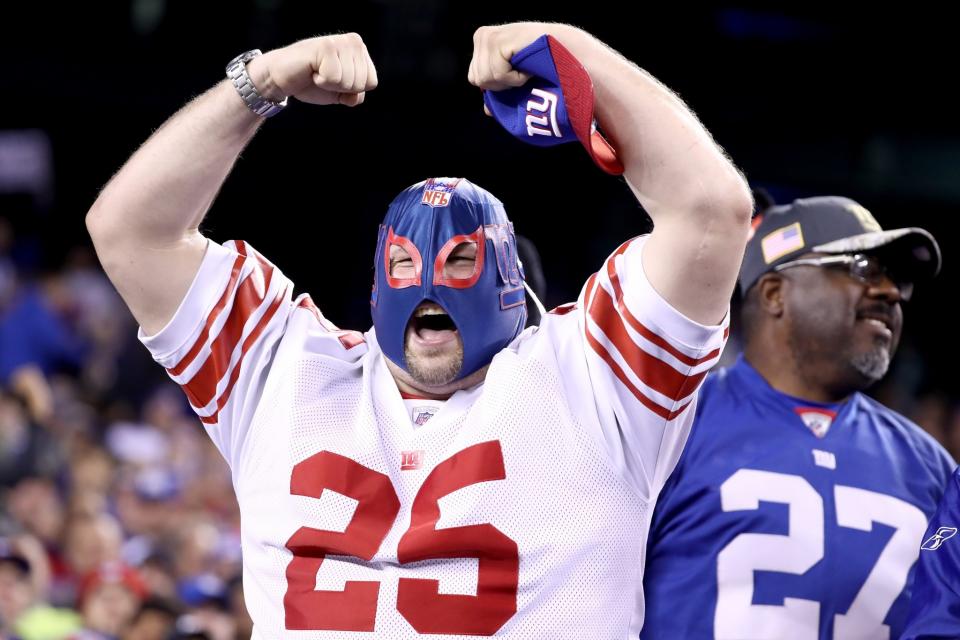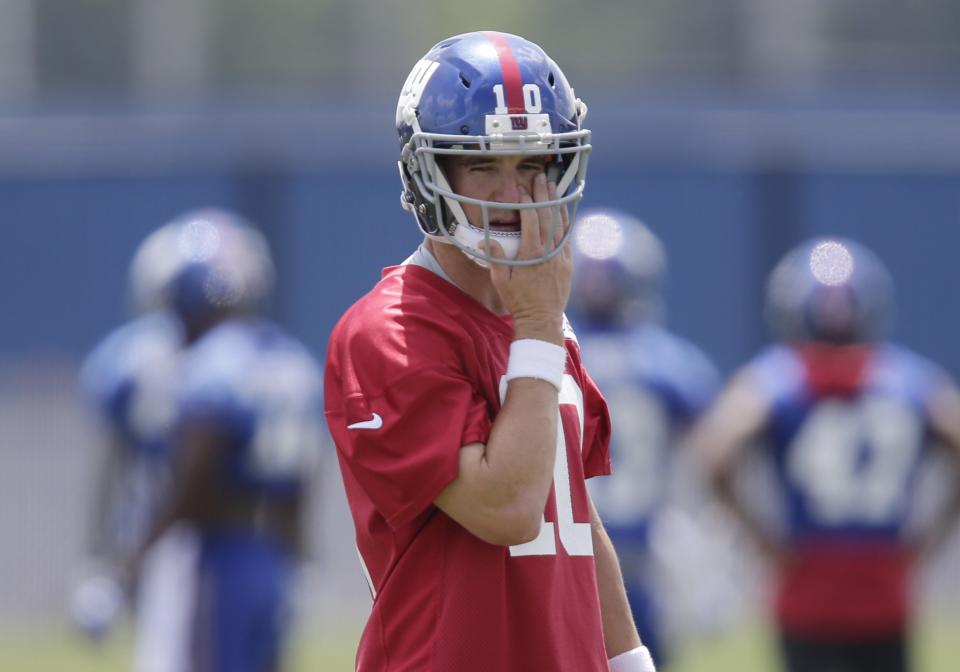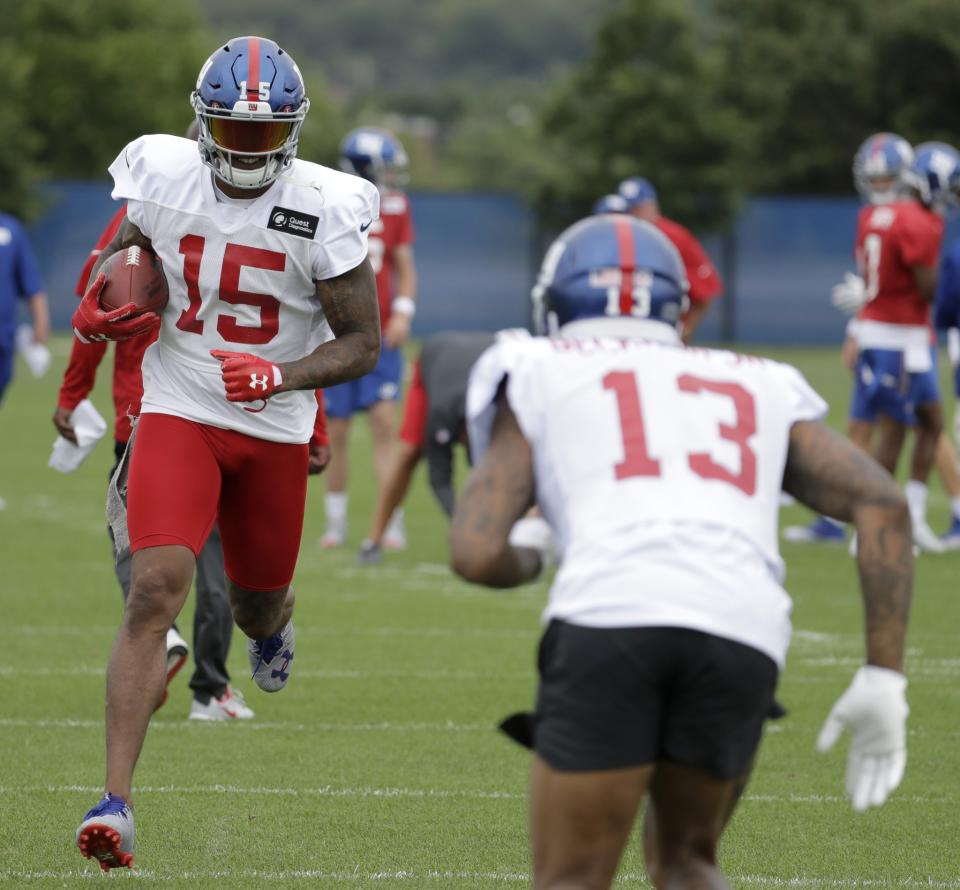Juggernaut Index, No. 16: The Giants have an Eli problem

Key decision-makers at every level of the Giants organization, from the coaching staff to ownership, have spent the offseason either disparaging Eli Manning or looking ahead to the post-Eli era. You won’t hear anyone associated with this franchise discuss Manning’s future the way the Patriots talk about the possibility of Tom Brady playing deep into his 40s.
Eli, at 36, might be cooked.
[Now’s the time to sign up for Fantasy Football! Join for free]
Manning was often a mess last year, responsible for 20 of the team’s 27 giveaways. He averaged just 6.73 yards per pass attempt, the same as Ryan Fitzpatrick and less than both Case Keenum (6.84) and Colin Kaepernick (6.77). Manning completed 63.0 percent of his throws, but most of the attempts were quick, short-range passes. He ranked near the bottom of the league in air yards per attempt (3.5) according to Player Profiler. When he looked deep, he was terrible. Eli completed only 28.2 percent of his deep throws. For comparison’s sake, Drew Brees completed 51.4 percent and Brady finished at 47.2.
Manning’s struggles were of course not lost on his head coach. These were a few of Ben McAdoo’s comments back in the spring:
“We all know that turning the ball over 27 times isn’t acceptable,” McAdoo said from the NFL scouting combine. “We’re fortunate to have the wins that we had turning the ball over the way we turned the ball over. So we can’t turn the ball over that way. We need to handle the ball better, so we need to catch it better than we caught it, and we need to handle it in the pocket better.”
“The offensive line they need to play better. I agree with that. [But] I think Eli needs to do a better job of playing with fast feet, and I think he needs to sit on that back foot in the pocket.”
Remember the early days of McAdoo’s tenure in New York, when coaches openly discussed the possibility of Manning completing 70 percent of his pass attempts? More recently, his coaches simply want fewer of his misfires to end up in the hands of defensive players.
As Eli approaches the “Dancing With the Stars” phase of his public life — in which he will obviously shine — all we can reasonably hope for is another year of sporadic competence. New York’s receiving corps is gifted enough to drag him to another 4000-yard season, in all likelihood, but turnovers are a given. Eli never misses games, so there’s really no need to consider Cal rookie Davis Webb, or any of the sketchier names on the depth chart.

Is this the year Odell Beckham Jr. leads all receivers in fantasy scoring?
Beckham has finished as a top-five fantasy wide receiver in each of his three seasons, including his rookie year in which he only appeared in a dozen games. He’s exceptional, an all-time talent. Stickiest hands in the game. Beckham isn’t exactly stoic and unflappable at all times, but his skills are almost unmatched. He’s averaged 95.9 receiving yards per game over his three NFL seasons. Personally, I’d give a small edge to Antonio Brown in full-season ranks, for quality-of-quarterback reasons. But Beckham is phenomenal. He clearly belongs in the first half of the first round in any fantasy format. His absolute rock-bottom floor in a healthy season is still a top-ten positional finish. Beckham saw the second-most red-zone targets among all receivers last season (23) and the fourth-most targets inside the 5-yard line (7). There are no holes in his fantasy game.
(Let’s never forget that LSU once had Beckham, Jarvis Landry, Jeremy Hill, Alfred Blue and Zach Mettenberger on the same team, and somehow went 5-3 in conference, then finished the season in the Outback Bowl.)
Like other dominant receivers, Beckham has immense on-field gravity, tilting coverage his way and drawing attention from shadow corners. And still he piles up 90-plus yards each week. Look at this ridiculousness. OBJ’s presence should make receiving life easy for new addition Brandon Marshall, a player who hasn’t functioned as a secondary target on any team since his rookie year. Marshall is now 33 and coming off a lost season with a lost franchise, but he’s just one season removed from catching 109 balls for 1502 yards. Over the course of Marshall’s 12-year, five-team, four-city career, he’s been paired with several of the league’s most comically inept and/or self-defeating quarterbacks. (Cutler, Fitz, Henne, Campbell, Orton, Geno, et al.) Eli isn’t going to show him any weirdness that he hasn’t seen before.

Marshall has made it clear that he recognizes his place in the Giants’ receiving hierarchy, so no worries there. Back in March, he declared that Beckham was the unchallenged No. 1 and he and Sterling Shepard were co-No. 2s, members of the supporting cast. New York offers a terrific situation for Marshall at this stage; Beckham should help him more than he helps Odell. Marshall is being drafted as almost an afterthought (ADP 74.2, WR29), at a spot where he can reasonably deliver a small profit. He’s still a 6-foot-5 receiver with uncommon strength for his position, and an ability to box out pretty much any corner in single coverage.
[Now’s the time to sign up for Fantasy Football! Join for free]
Shepard caught 65 balls for 683 yards and eight scores as a rookie, and he made plenty of noise in December (3 TDs), when the fantasy community needed him most. There’s little question that his fantasy outlook took a minor hit with the Marshall signing, but let’s not dismiss him entirely. Beckham and Marshall will demand extreme attention, leaving Shepard, at least in theory, with room to operate from the slot. We shouldn’t bank on another eight spikes from Shepard in 2017, but 60-plus receptions is certainly in play. Shepard went down with a training camp injury on Wednesday, initially believed to be severe, but early reports suggest it’s a simple low ankle sprain. No reason to panic.
The Giants used a first-round draft pick on Ole Miss tight end Evan Engram, and he’s clearly in the team’s plans for 2017. Engram reportedly lined up everywhere throughout OTAs. At 6-foot-3 and 240, he’s not a plus-sized tight end. Engram is more of a Jordan Reed-type, a player who should be used almost exclusively as a receiving threat. Engram caught 162 balls as a four-year collegiate player, including 65 for 926 yards last season. He’s a serious weapon and he had an outstanding combine. First-year tight ends rarely make an impact in fantasy, however, and we have to view Engram as the fourth or fifth option in New York’s passing game. If he carves out a red-zone role, he’ll eventually work his way into our weekly position ranks. For now, he’s strictly a dynasty target.
Paul Perkins, featured runner. Hmmm.
Rashad Jennings is no longer in the team picture in New York, leaving second-year back Paul Perkins as the team’s featured runner. McAdoo has already exempted Perkins from any sort of camp competition…
McAdoo also said, surprisingly, that Paul Perkins is the starting running back. That is not a surprise, but McAdoo saying it is a surprise.
— Paul Schwartz (@NYPost_Schwartz) May 1, 2017
…so fantasy drafters need to treat him as a back with an unobstructed path to 240-or-so touches. Perkins closed the regular season well as a rookie, averaging 4.5 YPC over the final five games and rushing for 102 yards in Week 17. He doesn’t have a breakaway gear and only two of his 112 total carries went for 20-plus yards last season. But volume is king in our game, and Perkins will get all the carries he can handle, with goal line work included. Draft accordingly. He’s a fair value at his current Yahoo ADP (92.9).
Perkins was not heavily involved as a receiving threat last season (15 catches on 24 targets), and that probably won’t change much in 2017. A triceps injury limited Shane Vereen to just five games last season, but he remains with the Giants and should be good to go in opening week. Vereen caught a career-high 59 passes for 495 yards in New York in 2015, and he should have a similar role in the year ahead. Remember, this team is all about the short passing game. Vereen should not be forgotten in PPR drafts.
New York drafted Clemson back Wayne Gallman in the fourth round, but he’s little more than a deep league end-game dynasty flier. He was a quality collegiate runner in an explosive offense, but he’s not an exceptional athlete by NFL standards. More importantly, he’s firmly behind Perkins and Vereen on the depth chart. There’s no obvious need to chase Gallman in leagues of standard size and shape.
New York’s defense is legit.
The Giants spent big on D in free agency last offseason, and it’s tough to fault the decision. The team ranked dead-last in total yards allowed in 2015 (420.3 YPG), then climbed all the way to tenth last year (339.7). New York was stellar against the run, allowing just 88.6 YPG on the ground and only 3.6 YPC. This group also ranked second in the NFL in opponent passer rating (75.8) and tied for fourth in interceptions (17). Landon Collins emerged as an elite IDP last year, delivering 125 tackles, five picks and 4.0 sacks. So yeah, it’s a viable fantasy unit. New York’s division schedule isn’t exactly a cakewalk, but the Giants won’t face Brady, Brees, Rodgers, Ryan or Ben, which certainly helps. It would be a small surprise if this D/ST didn’t crack the top-10 again in 2017.
2016 Offensive Stats & Ranks
Points per game – 19.4 (26)
Pass YPG – 242.4 (17)
Rush YPG – 88.3 (29)
Yards per play – 5.2 (21)
Plays per game – 63.6 (16)
—
Previous Juggernaut Index entries: 32) NY Jets, 31) San Francisco, 30) Cleveland, 29) LA Rams, 28) Baltimore, 27) Chicago, 26) Minnesota, 25) Detroit, 24) Denver, 23) Jacksonville, 22) Buffalo, 21) Philadelphia, 20) Miami, 19) Indianapolis, 18) Kansas City, 17) Washington, 16) NY Giants


